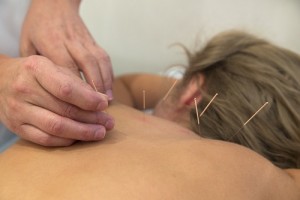
Acupuncture, or Dry Needling as we sometimes refer to it, is starting to become common practice amongst Physiotherapists today. At Enhance Physiotherapy all our Physiotherapists are trained in the use of Dry Needling and we use it on a daily basis to help manage pain and muscle tightness amongst other things. But what is Dry Needling? How does it work?
Although there are differences between the terms ‘Acupuncture’ and ‘Dry Needling’, we will use them interchangeably throughout this information. In practice we use Dry Needling, but often refer to it as Acupuncture so people know what we’re talking about.
Dry Needling involves inserting a very fine needle into a muscle. Once the needle is in position it is left in the muscle for a short period of time (normally anywhere from 5 seconds to 15 minutes) before it is removed. Your therapist may choose to adjust or ‘twirl’ the needle while it is in place to maximise the effects. Sometimes your therapist will insert just one needle or they may insert several, depending on the area being treated and the desired effect.
Myofascial Trigger Points (MTPs), more commonly known as ‘knots’ in a muscle, are a common cause of pain and disability in the neck, shoulders and lower back. But they occur naturally in all muscles. When a muscle is put under stress, either due to poor posture or from excessive workload, these trigger points become exacerbated and increase in tension. What this means is that the muscle fails to relax adequately and remains active. This overall increase in muscle activation depletes the muscles energy, which can lead to further muscle tension as muscles require energy to relax.
Dry Needling helps by breaking this cycle of muscle tension, fatigue and aching. Inserting a needle into these MTPs elicits a twitch in the muscle which helps to release the bonds between muscle fibres, allowing the muscle to relax. Dry Needling also causes stimulation of nerves which transmit pain. This activates cells in the brain and spinal cord to suppress pain signals. As well as breaking down trigger points and suppressing pain signals, Dry Needling also triggers an increase of blood flow to the area being treated. Adequate blood flow is essential in the healing of body tissues because it supplies nutrients and blood cells to allow healing to take place, and it removes debris and dead cells caused by the initial injury.
Is Acupuncture safe?
Yes. Dry Needling is an EXTREMELY safe form of treatment. Side effects include:
- Bruising: Occur in 3% of treatments
- Infection: very rare; occur in 0.014% of treatments
- Fatigue: prevalence not known (but in our experience is uncommon)
- Fainting: very rare, but can occur particularly in patients who have never had it before and if patients are afraid of needles in general.
All our therapists are trained in the proper use of dry needling and we use sterile, single-use needles only to avoid side-effects.
At Enhance Physiotherapy we use Dry Needling on a regular basis, but often in conjunction with other therapies or treatments to form a holistic treatment approach. We think acupuncture/dry needling is a fantastic tool to have at our disposal. For those clients who feel anxious or uncomfortable about the use of needles in their treatment we will always be able to provide different forms of therapy to effectively manage their injury.
If you would like to give dry needling a try, or have any questions about needling then ask your Physiotherapist.

